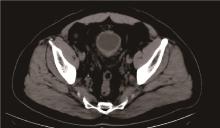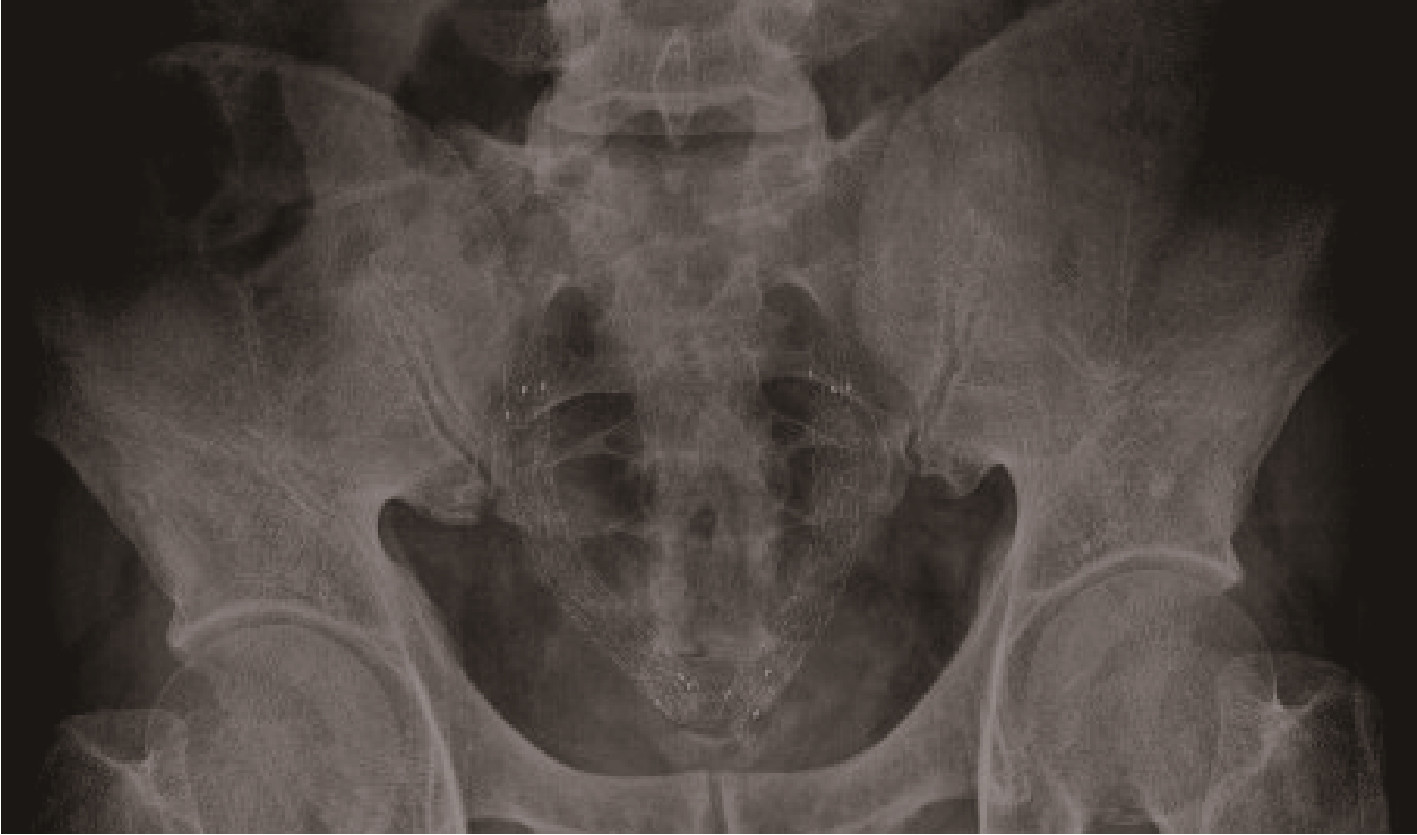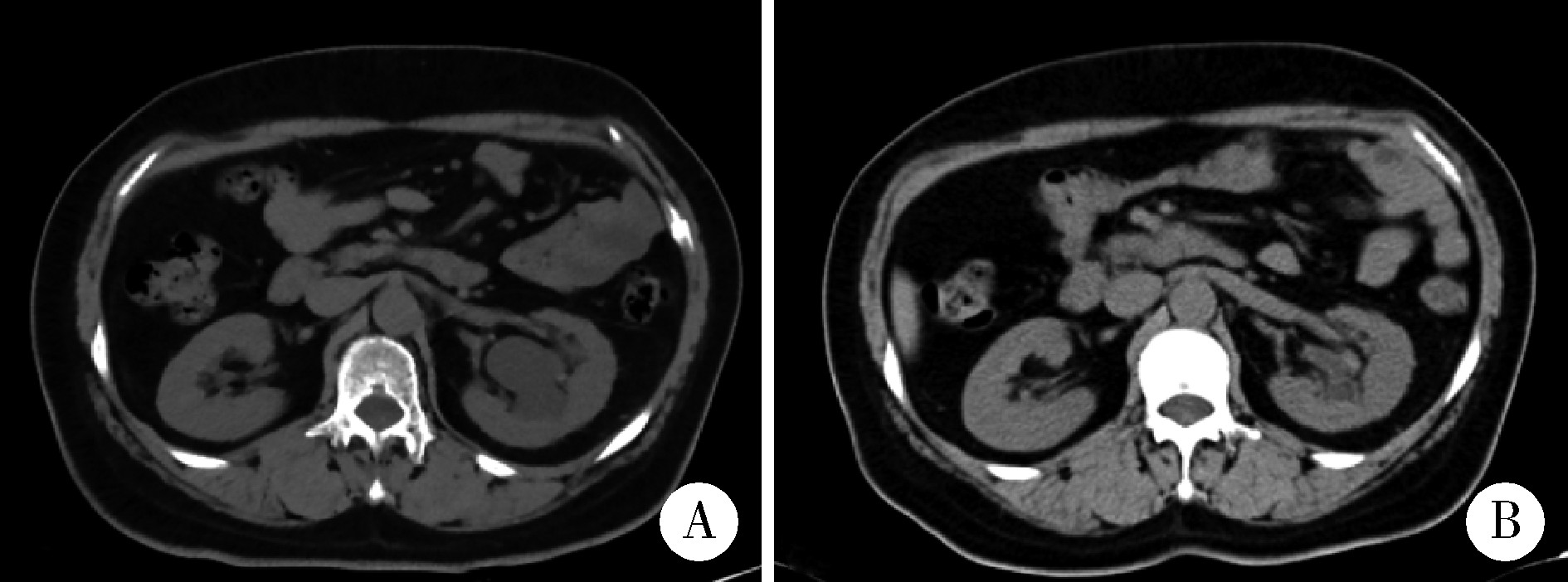北京大学学报(医学版) ›› 2024, Vol. 56 ›› Issue (5): 919-922. doi: 10.19723/j.issn.1671-167X.2024.05.026
覆膜金属输尿管支架治疗盆腔脂肪增多症所致肾积水的疗效
王明瑞, 王起, 胡浩*( ), 赖金惠, 唐鑫伟, 万春艳, 许克新, 徐涛
), 赖金惠, 唐鑫伟, 万春艳, 许克新, 徐涛
- 北京大学人民医院泌尿外科,北京大学应用碎石技术研究所,北京 100044
Efficacy of coated metal ureteral stent in the treatment of pelvic lipomatosis induced hydronephrosis
Mingrui WANG, Qi WANG, Hao HU*( ), Jinhui LAI, Xinwei TANG, Chunyan WAN, Kexin XU, Tao XU
), Jinhui LAI, Xinwei TANG, Chunyan WAN, Kexin XU, Tao XU
- Department of Urology, Peking University People's Hospital; The Institute of Applied Lithotripsy Technology, Peking University, Beijing 100044, China
摘要:
探讨留置覆膜金属输尿管支架(coated metal ureteral stent, CMUS)治疗盆腔脂肪增多症所致肾积水(pelvic lipomatosis induced hydronephrosis,PLH)的初步经验。回顾性分析2018年8月至2021年2月北京大学人民医院采用CMUS治疗PLH的8例患者的临床和随访资料。入组标准: 影像学证实盆腔内膀胱周围过多的脂肪组织,膀胱抬高呈“倒梨形”,膀胱壁增厚; 膀胱镜检查提示膀胱黏膜滤泡样增生,活检病理提示腺性膀胱炎; 单侧或双侧肾积水和输尿管扩张。排除标准: 输尿管闭锁; 反复加重的膀胱出口梗阻。记录患者的围手术期资料,其中术前基线资料包括患者年龄、性别、血肌酐、肾盂宽度和输尿管支架症状问卷(ureteric stent symptoms questionnaire,USSQ)评分,术中资料包括逆行尿路造影下观察的输尿管狭窄部位和长度,术后随访资料包括血肌酐、肾盂宽度和USSQ评分。本组8例(11侧)PLH患者全部为男性,平均年龄为(38.7±8.6)岁,单侧肾积水5例和双侧肾积水3例。术前平均血肌酐为(90.0±10.3) μmol/L,平均肾盂宽度为(3.0±1.5) cm,术中发现全部为输尿管下段狭窄,平均狭窄长度为(1.9±0.9) cm。术前有3例患者留置输尿管双猪尾管,USSQ评分分别为97.0、68.0和100.0分。5例患者逆行置入CMUS支架,3例采用顺逆行结合的方式。末次随访时平均血肌酐为(82.0±11.1) μmol/L,较术前显著降低(t=3.23,P=0.02);平均肾盂宽度为(1.9±0.5) cm,较术前显著降低(t=3.12,P=0.02);在术前留置双猪尾管的3例患者中,更换为CMUS后末次随访时USSQ评分分别为87.0、62.0和89.0分,患者症状均较术前改善。平均随访时间为(10.0±6.3)个月,随访过程中1例患者出现CMUS相关症状,未发现支架相关感染、支架结壳等并发症; 1例患者在术后3个月支架移位至膀胱,经尿道取出支架后随访3个月,肾积水基本消失。CMUS支架治疗PLH具备一定的有效性和安全性,可以作为PLH长期维持性治疗的新方法。
中图分类号:
- R692.2
| 1 |
Prabakaran R , Abraham G , Kurien A , et al. Pelvic lipomatosis[J]. Kidney Int, 2016, 90 (2): 453.
doi: 10.1016/j.kint.2016.05.009 |
| 2 |
周祥福, 高新, 方友强, 等. 盆腔脂肪增多症诊治分析[J]. 中华泌尿外科杂志, 2005, 26 (2): 125- 129.
doi: 10.3760/j:issn:1000-6702.2005.02.016 |
| 3 |
Sercan Ö . Pelvic lipomatosis associated with portal vein thrombosis and hydronephrosis: A case report[J]. J Int Med Res, 2019, 47 (6): 2674- 2678.
doi: 10.1177/0300060519840912 |
| 4 | Baas W , O'Connor B , El-Zawahry A . Bilateral hydronephrosis and acute kidney injury secondary to pelvis lipomatosis[J]. Can J Urol, 2018, 25 (1): 9217- 9219. |
| 5 | 方露, 于德新, 王毅, 等. 腹腔镜手术治疗盆腔脂肪增多症1例报告并文献复习[J]. 临床泌尿外科杂志, 2016, 31 (7): 660- 662. |
| 6 |
徐涛, 赵卫红, 王晓峰, 等. 盆腔脂肪增多症两例兄弟患者报道及文献分析[J]. 北京大学学报(医学版), 2007, 39 (4): 355- 360.
doi: 10.3321/j.issn:1671-167x.2007.04.006 |
| 7 |
Lange D , Bidnur S , Hoag N , et al. Ureteral stent-associated complications: Where we are and where we are going[J]. Nat Rev Urol, 2015, 12 (1): 17- 25.
doi: 10.1038/nrurol.2014.340 |
| 8 | 刘喆, 欧阳骏. 盆腔脂肪增多症的诊断和治疗[J]. 临床泌尿外科杂志, 2013, 28 (1): 13- 15. |
| 9 |
Chen Y , Yang Y , Yu W , et al. Urodynamic characteristics of pelvic lipomatosis with glandular cystitis patients correlate with morphologic alterations of the urinary system and disease severity[J]. Neurourol Urodyn, 2018, 37 (2): 758- 767.
doi: 10.1002/nau.23343 |
| 10 |
Fiuk J , Bao Y , Calleary JG , et al. The use of internal stents in chronic ureteral obstruction[J]. J Urol, 2015, 193 (4): 1092- 1100.
doi: 10.1016/j.juro.2014.10.123 |
| 11 |
Bahouth Z , Moskovitz B , Halachmi S , et al. Allium stents: A novel solution for the management of upper and lower urinary tract strictures[J]. Rambam Maimonides Med J, 2017, 8 (4): e0043.
doi: 10.5041/RMMJ.10313 |
| 12 | Bahouth Z , Meyer G , Halachmi S , et al. Multicenter experience with Allium ureteral stent for the treatment of ureteral stricture and fistula[J]. Harefuah, 2015, 154 (12): 753- 756. |
| 13 | Leonardo C , Salvitti M , Franco G , et al. Allium stent for treatment of ureteral stenosis[J]. Minerva Urol Nefrol, 2013, 65 (4): 277- 283. |
| 14 |
董文敏, 王明瑞, 胡浩, 等. Allium覆膜金属输尿管支架长期留置治疗输尿管-回肠吻合口狭窄的初期临床经验及随访结果[J]. 北京大学学报(医学版), 2020, 52 (4): 637- 641.
doi: 10.19723/j.issn.1671-167X.2020.04.007 |
| 15 |
王明瑞, 胡浩, 王起, 等. Allium覆膜金属输尿管支架长期留置治疗放疗后输尿管狭窄的有效性和安全性[J]. 中华泌尿外科杂志, 2020, 41 (12): 921- 926.
doi: 10.3760/cma.j.cn112330-20200623-00488 |
| [1] | 陈思鹭, 王海菊, 吴宇财, 李志华, 黄燕波, 何宇辉, 许洋洋, 李学松, 贯华. 成人肾积水病因分析:一项单中心横断面研究[J]. 北京大学学报(医学版), 2024, 56(5): 913-918. |
| [2] | 秦彩朋,王飞,杜依青,张晓威,李清,刘士军,徐涛. 无症状无积水输尿管结石4例患者的诊治[J]. 北京大学学报(医学版), 2023, 55(5): 939-942. |
|
||






